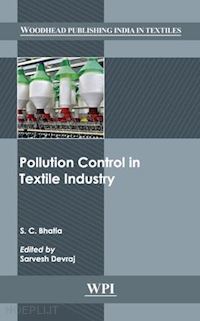
Questo prodotto usufruisce delle SPEDIZIONI GRATIS
selezionando l'opzione Corriere Veloce in fase di ordine.
Pagabile anche con Carta della cultura giovani e del merito, 18App Bonus Cultura e Carta del Docente
Textile processing industry is characterised not only by the large volume of water required for various unit operations, but also by the variety of chemicals used for various processes. There is a long sequence of wet processing stages requiring input of water, chemical and energy and generating wastes at each stage. Any industrial activity causes pollution in one form or the other and so is the textile industry. The textile industry is a significant contributor to many national economies, encompassing both small and large-scale operations worldwide. Textile processing generates many waste streams, including liquid, gaseous and solid wastes, some of which may be hazardous. Several measures for pollution control in textile industry are discussed in detail including ‘End-of-pipe’ technologies for wastewater treatment.
This book on pollution control in textile industry summarises various aspects of pollution control and is divided into 19 chapters. This edition discusses: enzymatic treatment of wastewater containing dyestuffs, degradation of toxic dyes, biological methods of removal of dyes from textile effluents, water conservation in textile industry, recovery of dyes and chromium from textile industry, zero liquid discharge in textile industry, pollution prevention in jute industry and wastes minimisation in textile industry. A unique feature of the book are the chapters on carbon foot print and energy conservation in textile industry. Finally the role of nanotechnology for the removal of dyes and effluents in also discussed.
CHAPTER 1: TEXTILE INDUSTRY: AN OVERVIEW
Textile manufacturing processes
Preparation of fibre
Spinning - conversion of fibre into yarn
CHAPTER 2: TEXTILE INDUSTRY AND ITS IMPACT ON ENVIRONMENT
Components of textile industry
Pollution aspects of textile industry
Processes involved
Waste stream
Some facts regarding environmental issues
Wastes generated
Pollution from areas other than chemical processing
Pollutants involved in the wet processing
Solution to environmental problems
CHAPTER 3: BIOPROCESSING OF TEXTILES
Role of enzymes in textile processing
Classification of enzymes
Enzyme applications in textile preparatory process
Silent features of enzymes application in textile processing
CHAPTER 4: ENZYMATIC TREATMENT OF WASTEWATER CONTAINING DYESTUFFS
Need for dye removal from effluents
Conventional processes for removal of dyes from effluent streams
Enzymes in wastewater treatment
Delivery systems for enzymes in effluent treatment
CHAPTER 5: DEGRADATION OF TOXIC DYES
Various types of dyes
Methods of decolouration of dyes
CHAPTER 6: Biological methods of removal of dyes from textile effluents
Methods for textile dye removal
CHAPTER 7: WATER CONSERVATION IN TEXTILE INDUSTRY
Water usage
Modern technologies can save water in textile industry
CHAPTER 8: NOISE POLLUTION AND ITS CONTROL IN TEXTILE INDUSTRY
Noise sources
Industrial noise sources
Control of noise pollution
Techniques for reducing textile machinery noise
Lead-loaded fabrics
Control of noise in pumps and valves
Management of noise pollution control
Case study: Noise control in textile industry
CHAPTER 9: RECOVERY OF DYES AND CHROMIUM FROM TEXTILE INDUSTRY
PVA recovery
Caustic recovery
Indigo recovery
Efficient methods for the removal of chromium from textile effluents
CHAPTER 10: ZERO LIQUID DISCHARGE IN TEXTILE INDUSTRY
Highlights of ZLD in textile sector
Promoting zero liquid discharge to Indian textile industry
Benefits and challenges facing the ZLD mandate in Indian textile sector
Factors to be considered in framing policies for ZLD
Indian policy experience for promoting ZLD in the textile sector
Zero liquid discharge in dyes and dye intermediates
Problems of textile processing units in installation of ZLD
Way ahead
CHAPTER 11: HAZARDS, RISKS AND SAFETY IN TEXTILE INDUSTRY
Typical processes in textile finishing
Chemical hazards
Chemical safety programme
Risk assessment
Safety measures
Emergency preparedness
CHAPTER 12: CELLULOSIC FIBRES (VISCOSE, ACETATE AND CUPRAMMONIUM RAYON)
Manufacture of viscose, acetate and cuprammonium rayon
Polyester fibre
Wool
Rayon wastes treatment in U.S. and Germany
Treatment and disposal of fibre wastes
Treatment and reuse of wastewater from polyester dyeing houses
Application of enzymes for textile fibres processing
CHAPTER 13: POLLUTION PREVENTION IN JUTE INDUSTRY
Jute fibre
Manufacturing aspects of jute
Pollution aspects in jute mills
Jute retting
Minimal national standards (MINAS)
CHAPTER 14: TEXTILE EFFLUENT TESTING
Analysis of samples
CHAPTER 15: CARBON FOOTPRINT IN TEXTILE INDUSTRY
Reducing of carbon foot print
Machinery/equipment related
Sustainability of textiles
Creating new green paradigm
Creating a carbon free environment
LCA, carbon footprint and ecological footprint
CHAPTER 16: ENERGY CONSERVATION IN TEXTILE INDUSTRY
Energy consumption in textile industry
Waste heat recovery in textile industries
Cost effectiveness in textile processing
Good housekeeping
CHAPTER 17: WASTES MINIMISATION IN TEXTILE INDUSTRY
Yarn realisation
Waste control in spinning mill
Waste investigation
Waste reduction and control
Fibre waste recycling and its future
Managing waste in the textiles manufacturing industry
Textile waste minimisation
Trends and future applications
CHAPTER 18: NANOTECHNOLOGY IN TEXTILE INDUSTRY
Definitions of nanotechnology
Nanomaterials
Nanotechnology in the textile industry
Quality label for nanotechnology
Application of nanotechnology in textile industry
CHAPTER 19: NANOTECHNOLOGY FOR REMOVAL OF DYES AND EFFLUENTS
Removal of azo dyes by nanotechnology
Nano-silica-silver composite material for removal of textile effluents and dyes
REFERENCE
INDEX











Il sito utilizza cookie ed altri strumenti di tracciamento che raccolgono informazioni dal dispositivo dell’utente. Oltre ai cookie tecnici ed analitici aggregati, strettamente necessari per il funzionamento di questo sito web, previo consenso dell’utente possono essere installati cookie di profilazione e marketing e cookie dei social media. Cliccando su “Accetto tutti i cookie” saranno attivate tutte le categorie di cookie. Per accettare solo deterninate categorie di cookie, cliccare invece su “Impostazioni cookie”. Chiudendo il banner o continuando a navigare saranno installati solo cookie tecnici. Per maggiori dettagli, consultare la Cookie Policy.